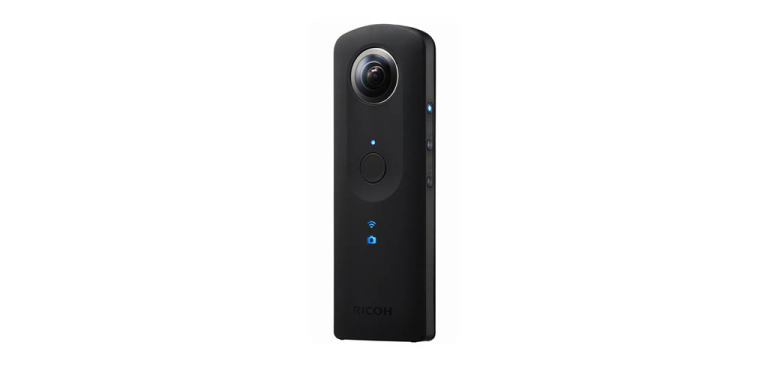Ricoh Theta S
Released on October 30, 2015, the Ricoh Theta S is a compact yet user-friendly entry-level 360° camera designed to cater to casual users, particularly those who are enthusiastic about social media. Its standout feature is the ability to capture immersive 360-degree images and videos, allowing users to encapsulate their surroundings without the constraints of framing. While it garners praise for its ease of use and decent photo quality courtesy of its 14 MP sensors, the camera's video capabilities, limited to 1080p, fall short compared to competitors like GoPro and DJI, especially in low-light conditions. Despite its fun features and compact design, some drawbacks, such as a non-removable battery and integrated storage, may hinder its practicality for more serious applications.
Reasons to Buy
- User-Friendly Design: The camera is compact, easy to use, and can operate with just one button, appealing to beginners.
- 360-Degree Capture: Ideal for immersive experiences, capturing everything around without needing to frame shots meticulously.
- Built-in Wi-Fi and App Control: Streamlined integration with smartphone apps for real-time control and media transfer enhances functionality.
- Affordable Price Point: At around $350, it provides good value for a consumer-level 360 camera with decent image quality for social media use.
Reasons to Avoid
- Limited Video Quality: Video resolution is only 1080p at 30 fps, which can appear soft when viewed on larger screens, making it inferior to higher-end models.
- No External Storage Options: The absence of an SD card slot means users are limited to 8GB of internal storage, which fills quickly.
- Digital Stitching Issues: Users report visible seams and issues during stitching, affecting video quality, especially in close-up shots.
- Battery Life Concerns: While recording times can reach 25 minutes, the battery life can be short, especially when live streaming or under heavy use, limiting prolonged shooting sessions.
The Ricoh Theta S features a compact design measuring 4.4 cm by 13.0 cm and weighing only 125 grams, making it highly portable. It is equipped with a 14 MP camera, capable of 360-degree recording in the JPG photo format and MP4 video format, supporting a video frame rate of 1080p at 30 frames per second. The camera incorporates a fixed 360 lens with an f/2.0 aperture, providing good low-light performance. It does not support removable batteries, and users are limited to integrated storage of 8GB, with no options for external SD cards. Additionally, the camera lacks a rear screen and does not feature Bluetooth connectivity, but it does offer built-in Wi-Fi for app control. It includes features like night mode, burst mode, and time-lapse mode while supporting video stabilization through various digital modes. The charging port is USB-C, and although the microphone quality is average, there's no support for external microphones. The camera’s audio and video capabilities, while sufficient for casual use, are limited for professional quality outputs.
One of the most significant advantages of the Ricoh Theta S is its user-friendly layout, which makes it particularly attractive for beginners venturing into the world of 360 photography. The straightforward operation that allows for one-button recording empowers users to capture stunning 360-degree images with minimal hassle. The 14 MP resolution is effective for producing striking photos, and the automatic stitching feature means that users can spend less time processing shots and more time enjoying their experiences. Built-in Wi-Fi allows for seamless integration with smartphone applications, making it easier to manage and share content on social media platforms. Moreover, at a price point of approximately $350, the Theta S provides solid value for those seeking a consumer-friendly 360 camera without breaking the bank.
However, the Ricoh Theta S does come with notable limitations that could dissuade potential buyers. The most pressing issue is the camera's video quality, which only reaches 1080p at 30 fps. This resolution is significantly lower than that offered by many competitors and results in softer images, particularly when viewed on larger displays. Additionally, the lack of external storage options means that users must contend with just 8GB of internal memory, which fills quickly, especially with video. Many users have reported problems with digital stitching, leading to visible seams that can disrupt the immersive experience, particularly during close-up filming. Furthermore, the non-removable battery is a drawback, as it limits recording times to a maximum of 25 minutes, which can pose challenges during extended shooting sessions or live streams.
When comparing the Ricoh Theta S to its predecessors, particularly the earlier Theta models, there are several improvements that stand out. The Theta S showcases enhanced photo quality and improved stitching technology, yielding better overall results than previous iterations. Moreover, the addition of built-in Wi-Fi for app control is a significant upgrade, allowing greater ease of use compared to older models which lacked this feature. However, even with advancements, it falls short against newer models that boast higher resolutions and improved functionalities.
The Ricoh Theta S is best suited for casual users, social media enthusiasts, and families wanting to document their gatherings with immersive 360-degree imagery without the complexity of more professional gear. Its straightforward operation and compact design make it an excellent choice for those who prioritize ease of use and fun over the highest video quality. It's perfect for events like family reunions, vacations, and casual adventures where capturing memories in a unique format is the goal.
Ricoh Theta S Specifications
Ultimately, the Ricoh Theta S serves its purpose as a user-friendly entry-level 360 camera. While it excels in photo quality and ease of use, its video limitations and storage constraints may not meet the needs of more advanced users or those seeking high-quality footage.
